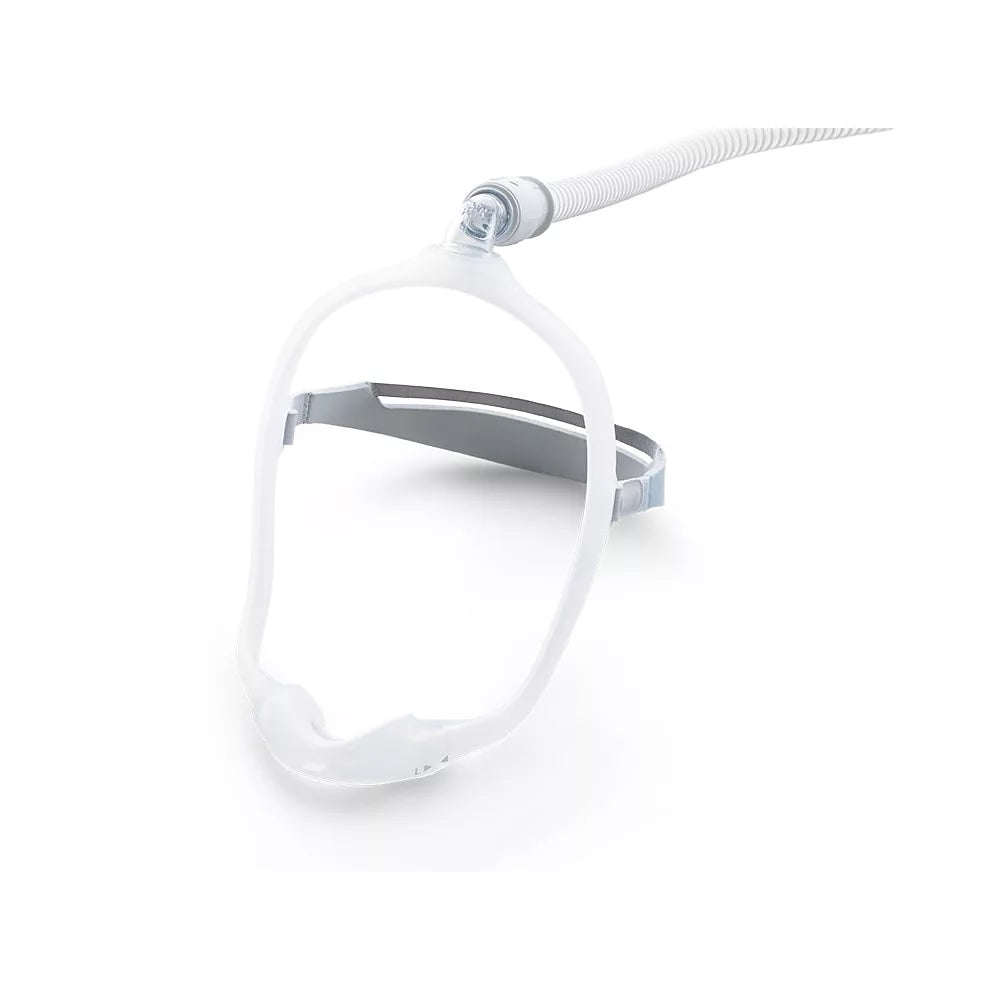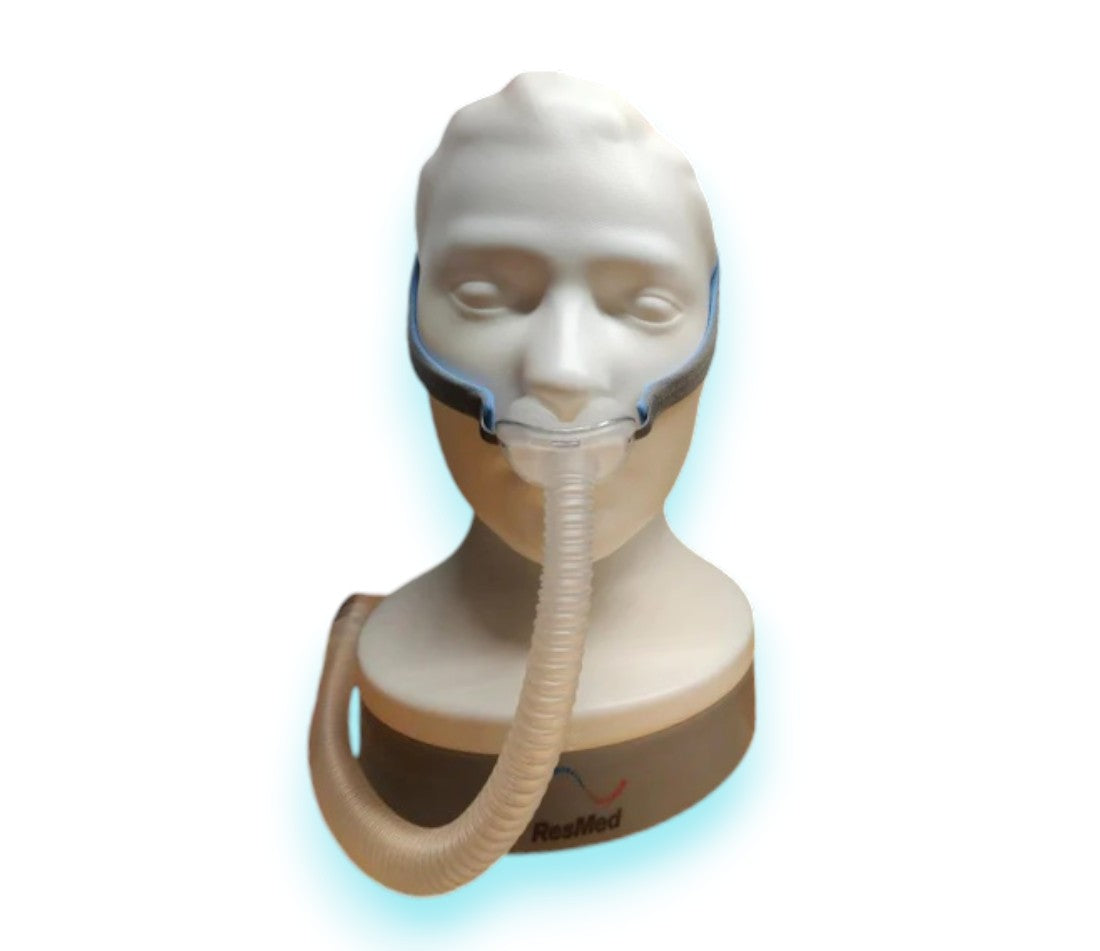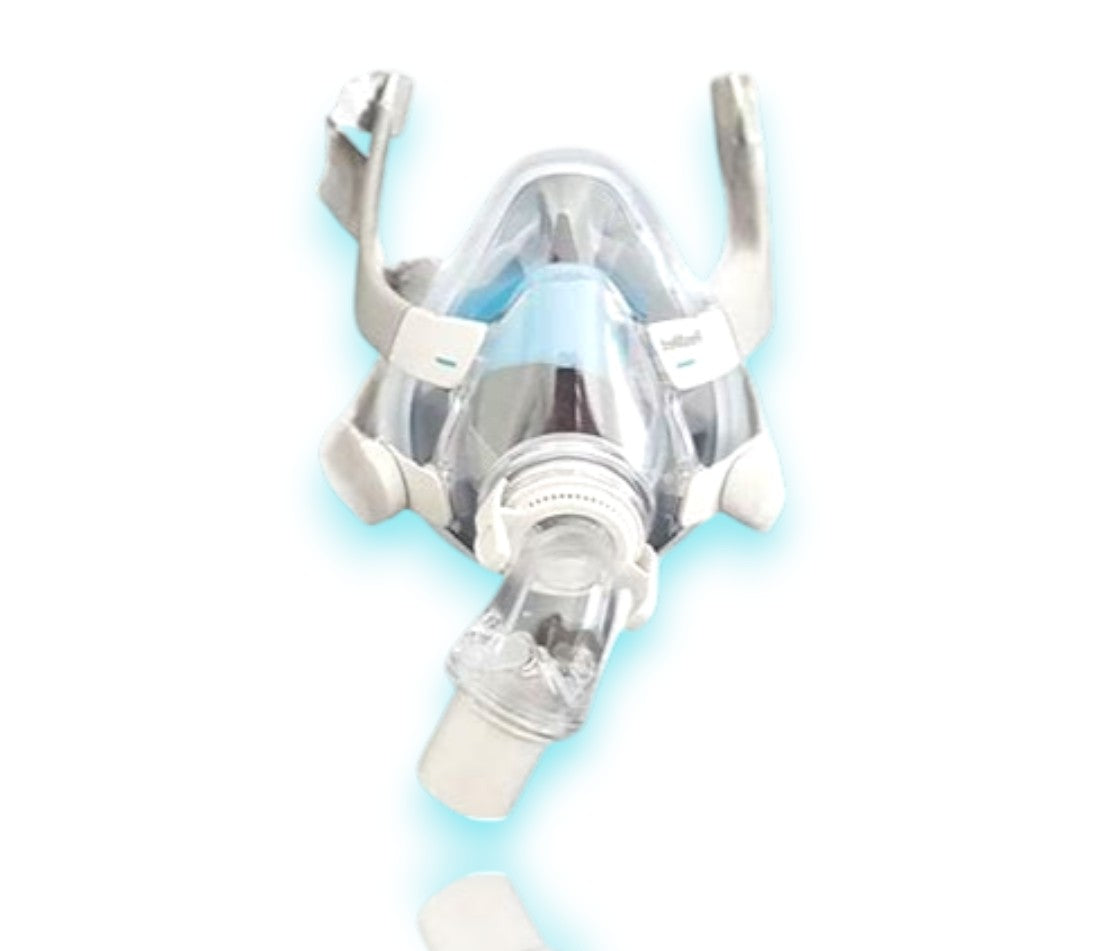A: The headgear and straps of the DreamWear Nasal CPAP Mask are adjustable. Loosen or tighten them until you achieve a secure yet comfortable fit. The mask should not be too tight, causing discomfort, or too loose, leading to air leaks.
Philips Respironics DreamWear Nasal CPAP Mask with Headgear | FitPack (M Frame & S/M/L/MW Cushion) | 1116700
- In Stock
Size
- Description
- Parts
- Specs
- Included Items
- Reviews 49
- Q&A
The Philips Respironics DreamWear Nasal CPAP Mask with Headgear is designed to provide a comfortable, effective, and user-friendly solution for individuals undergoing CPAP therapy. This mask stands out for its unique under-the-nose design and innovative headgear, offering a superior alternative to traditional nasal CPAP masks. Whether you are a new CPAP user or looking to upgrade your current mask, the DreamWear nasal mask provides exceptional comfort, flexibility, and efficiency.
Product Highlights (Philips 1116700)
- Minimal Facial Contact: The CPAP DreamWear nasal mask features an under-the-nose design that minimizes contact with the face, reducing pressure points, red marks, and discomfort. The cushion sits comfortably under the nose, providing a secure seal without covering the entire nose.
- Soft Silicone Frame and Nasal Pillows: The soft silicone frame and nasal pillows of this dream wear nasal mask adapt to the face’s contours, offering comfort and a secure seal while minimizing skin irritation.
- Multiple Sizes (S, M, MW, L): Available in Small, Medium, Medium-Wide, and Large sizes, ensuring a proper fit for various facial structures and enhancing comfort and seal for optimal CPAP therapy.
- Plush Headgear: The plush headgear of this nasal mask DreamWear offers soft, secure support, holding the mask in place without causing discomfort or irritation during sleep.
- Dual-Wall Nasal Pillows: The dual-wall nasal pillows of this dream wear CPAP mask feature a soft inner layer for comfort and a firmer outer layer for stability, ensuring a secure seal and preventing air leaks.
-
Quiet Operation
Diffused vents direct exhaled air away from the user and their partner, minimizing noise for a quieter sleep environment. - Minimal Air Leaks: The under-the-nose cushion and dual-wall nasal pillows provide a secure seal, minimizing air leaks and improving the effectiveness of CPAP therapy.
- Top-of-Head Tube Connection: The top-of-head connection of this DreamWear CPAP mask keeps tubing out of the way, allowing freedom of movement in any sleep position and preventing tangling.
- Open Field of Vision: This Respironics CPAP masks offers an unobstructed view, allowing users to read, watch TV, or wear glasses, enhancing comfort and reducing feelings of claustrophobia.
- Easy to Clean and Maintain: The silicone components are easy to disassemble, clean, and reassemble, ensuring hassle-free maintenance for optimal hygiene and performance.
- Lightweight Design: The lightweight design of this Philips CPAP mask minimizes bulk and discomfort, offering a more natural feel and making it ideal for users who feel restricted by heavier masks.
- Durable Construction: Built with high-quality materials, the Philips nasal mask is durable, ensuring long-lasting performance and reliable CPAP therapy without frequent replacements.
Philips DreamWear Nasal vs. ResMed AirFit N30: Comparison Table
Choosing the right nasal mask can greatly enhance your CPAP experience. Here's a quick comparison between the Philips DreamWear Nasal Mask and the ResMed AirFit N30 to help you find the best fit for your needs.
| Feature | Philips Respironics DreamWear Nasal CPAP Mask | ResMed AirFit N30 Nasal CPAP Mask |
|---|---|---|
| Design | Under-the-nose cushion with top-of-head tubing | Nasal cradle cushion with front connection |
| Material | Soft silicone | Soft silicone |
| Sizes Available | Small, Medium, Medium-Wide, Large | Small, Medium, Small-Wide, Large |
| Comfort | Minimal contact, flexible frame | Light and minimal design |
| Seal Technology | Dual-wall cushion for secure seal | AutoFit technology for automatic sealing |
| Air Leaks | Minimal due to under-nose design | Low due to cradle cushion design |
| Noise Level | Quiet with diffused exhalation | QuietAir vent technology for minimal noise |
| Compatibility | Compatible with other DreamWear components | Compatible with AirMini travel CPAP |
| Ease of Cleaning | Easy to disassemble and clean | Simple design, easy to clean |
| Durability | Durable construction | Durable with proper care |
| Field of Vision | Open field of vision | Open field of vision |
| Weight | Lightweight design | Ultra-lightweight design |
| Ideal For | Side sleepers, active sleepers, claustrophobic users | Minimalists, active sleepers, travel CPAP users |
| Replacement Schedule | Cushion: 1-3 months, Frame: 3-6 months | Cushion: 1-3 months, Headgear: 3-6 months |
| Additional Features | Interchangeable cushions, flexible tubing | Quick-release elbow, single side-clip headgear |
| Cost | Moderate | Moderate |
| User Reviews | Positive for comfort and freedom of movement | Positive for simplicity and minimal design |
Benefits of Philips Respironics DreamWear Nasal Mask
1. Enhanced Comfort
The under-the-nose design and soft silicone frame provide exceptional comfort. The minimal contact with the face reduces pressure points and the likelihood of skin irritation, making it ideal for users with sensitive skin.
2. Optimal Seal
The DreamWear nasal mask offers an optimal seal, reducing air leaks and enhancing the effectiveness of CPAP therapy. The secure fit ensures that the mask stays in place throughout the night, providing consistent and reliable therapy.
3. Versatility
This mask is compatible with all CPAP machines and can be easily integrated into your existing CPAP setup. The interchangeable cushions and modular design allow for customization and flexibility.
4. Improved Sleep Quality
By minimizing disturbances and providing a comfortable fit, the DreamWear nasal mask helps improve sleep quality. The quiet operation and secure seal ensure uninterrupted therapy, leading to better overall health and well-being.
Variants Available for Philips Respironics DreamWear Nasal CPAP Mask Cushion
Small
The small size cushion is designed for users with smaller facial structures, ensuring a snug and comfortable fit. It is ideal for those who have found standard sizes too large, providing a tailored fit that enhances the seal and comfort. This size helps to prevent air leaks and ensures the mask stays securely in place throughout the night. The precise fit reduces pressure points, which can minimize the risk of skin irritation and red marks, making it a great choice for users with delicate skin.
Medium
The medium size cushion is suitable for average-sized faces, providing a balanced fit and effective seal. This size is often the most popular as it caters to the majority of users. The medium cushion ensures a good mix of comfort and stability, helping to maintain a consistent and effective seal that is crucial for successful CPAP therapy. Its design allows for easy adjustments, ensuring a secure fit that minimizes discomfort and enhances therapy compliance. The medium cushion of Resperonics DreamWear mask is also versatile, fitting well with various facial structures.
Medium-Wide
The medium-wide size cushion caters to users who need a slightly wider fit than the standard medium size. This option is perfect for those who find the medium size too narrow but do not require a large cushion. The medium-wide cushion of this Phillips nasal mask provides a broader contact area, which enhances the seal and comfort. It is designed to accommodate users with wider nasal bridges or fuller facial features, ensuring that they receive the same level of effective CPAP therapy without sacrificing comfort. This size helps to reduce the likelihood of air leaks and pressure sores, offering a comfortable and secure fit.
Large
The large size cushion is designed for users with larger facial structures, ensuring a comfortable and secure fit. This size provides ample coverage and a stable seal, which is essential for maintaining effective CPAP therapy. The larger cushion of Phillips DreamWear nasal mask helps to distribute pressure more evenly, reducing the risk of pressure points and skin irritation. It is ideal for users who have found standard sizes inadequate, offering a tailored fit that enhances both comfort and the effectiveness of the treatment. The large cushion ensures that the mask remains in place throughout the night, providing uninterrupted therapy.
Philips Respironics DreamWear Nasal CPAP Mask is Ideal For
Side sleepers
The DreamWear mask is particularly well-suited for side sleepers due to its unique design. Traditional CPAP masks often have bulky frontal components that can press against the pillow when sleeping on one's side, causing discomfort and potential air leaks. The DreamWear mask, however, features a minimal under-the-nose cushion and a frame that curves along the cheeks. This design of Philips CPAP nasal mask significantly reduces the mask's profile, allowing side sleepers to rest their head on the pillow without interference from the mask. The soft, flexible silicone frame also helps distribute pressure evenly, further enhancing comfort for side sleepers.
For more information or to explore top options for side sleepers, check out this collection of CPAP masks for side sleepers.
Those who prefer a minimalist design
For users who dislike the feeling of bulky equipment on their face, the DreamWear mask offers a refreshingly minimalist alternative. The DreamWear Respironics mask's design eliminates the need for a forehead support and reduces the amount of material that comes into contact with the face. The under-the-nose cushion is small and unobtrusive, while the hollow frame serves as both an air channel and a support structure. This streamlined approach not only enhances comfort but also provides a less clinical, more aesthetically pleasing appearance compared to many traditional CPAP masks.
Users seeking freedom of movement during sleep
One of the standout features of the Philips DreamWear mask is its top-of-head tube connection. Unlike conventional masks where the air hose connects at the front, this design routes the tubing over the top of the head. This configuration offers several advantages for active sleepers:
- It keeps the hose away from the face and chest, reducing tangling.
- It allows for greater freedom of movement, as users can roll over or change positions without worrying about tube placement.
- The weight and drag of the hose are transferred away from the mask itself, improving seal stability.
Individuals prone to claustrophobia
For CPAP users who struggle with feelings of confinement or claustrophobia, the DreamWear mask offers several beneficial features:
- The open-frame design provides an unobstructed field of vision, reducing the feeling of being "closed in" by the mask.
- The minimal face contact, particularly the absence of anything covering the bridge of the nose or forehead, can help alleviate anxiety associated with wearing a mask.
- The under-the-nose cushion allows for a more natural breathing sensation compared to masks that seal around or inside the nostrils.
- The overall lightweight and airy design contribute to a less restrictive feeling, which can be crucial for users battling claustrophobia while trying to adhere to their CPAP therapy.
For more options tailored to those prone to claustrophobia, check out this collection of CPAP masks for claustrophobic patients.
Assembly Guide for Philips Respironics Nasal Mask
Assembling the Philips Respironics DreamWear Nasal CPAP Mask is a straightforward process designed to ensure a secure and comfortable fit for effective CPAP therapy. Follow these steps to assemble your DreamWear nasal fit pack correctly:
Align the Cushion
- Identify the Cushion Orientation: Locate the markings on the cushion and the mask frame to ensure proper alignment. The cushion should be positioned so that it fits naturally under the nose, with the openings aligned to the nostrils.
- Position the Cushion: Hold the cushion and place it gently against the mask frame. Ensure the cushion's openings are correctly aligned with the mask frame's attachment points.
Attach the Cushion
- Press the Cushion into Place: Apply gentle pressure to the cushion, pressing it firmly into the mask frame. The cushion should snap into place securely. Avoid forcing the cushion, as this can damage the silicone material.
- Ensure a Snug Fit: Once the cushion is attached, run your fingers around the edges to ensure it is securely in place. There should be no loose edges or gaps between the cushion and the mask frame.
Check for Secure Fit
- Inspect the Seal: Check the connection between the cushion and the mask frame. Ensure there are no visible gaps or misalignments that could lead to air leaks. A secure fit is crucial for effective therapy and comfort.
- Test for Stability: Gently tug on the cushion to ensure it is firmly attached to the frame. The cushion should remain securely in place without shifting or detaching.
Adjust the Headgear
- Attach the Headgear: Position the headgear so that the straps align with the attachment points on the mask frame. Secure the headgear by attaching the straps to the mask frame's hooks or slots.
- Fit the Headgear: Place the mask on your face, ensuring the cushion sits comfortably under your nose. Adjust the headgear straps to achieve a snug yet comfortable fit. The headgear should hold the mask in place without causing pressure or discomfort.
- Fine-Tune the Fit: Once the headgear is attached, make any necessary adjustments to the straps to eliminate gaps and ensure a secure seal. The mask should feel comfortable, and there should be no pressure points or discomfort.
- Check for Proper Function: After assembly, connect the mask to your CPAP machine and turn it on. Check for any air leaks and adjust the headgear or cushion position if necessary. A properly assembled mask will provide a consistent and comfortable airflow.
Cleaning and Maintenance of the Philips Respironics DreamWear Under The Nose Nasal Mask
Daily Cleaning
Daily cleaning helps remove facial oils and residue that accumulate on the cushion and frame, ensuring a clean and hygienic mask for each night's use. To clean, simply remove the cushion from the mask frame and submerge both the cushion and the frame in warm, soapy water with a mild, non-antibacterial soap. Gently agitate them to clean all surfaces, then rinse thoroughly under warm running water to remove any soap residue. After shaking off excess water, place the parts on a clean, dry towel and let them air dry completely, away from direct sunlight or heat to prevent damage.
Weekly Cleaning
Weekly cleaning provides a more thorough cleaning to eliminate any buildup that daily cleaning may miss. Start by disassembling the mask into its individual parts: cushion, frame, headgear, and any other detachable components. Soak all parts in a mixture of warm water and mild detergent for about 30 minutes to loosen any stubborn residue. If needed, use a soft brush to gently scrub the cushion and frame, especially in areas with visible buildup. Once cleaned, rinse each part thoroughly under warm running water, shake off excess water, and place them on a clean, dry towel to air dry completely, avoiding exposure to direct sunlight or heat.
Headgear Cleaning
Cleaning the headgear removes oils, sweat, and dirt, maintaining its elasticity and comfort.
- Materials Needed: Remove the headgear from the mask frame, submerge it in warm water with a small amount of mild detergent, and gently agitate it to clean thoroughly.
- Avoid Machine Washing: Do not machine wash or dry the headgear, as this can damage the material and reduce its lifespan.
- Rinse Thoroughly: Rinse the headgear under warm running water to remove all detergent residue.
- Air Dry: Squeeze out excess water gently without wringing. Lay the headgear flat on a clean, dry towel and allow it to air dry completely.
For more tips and a complete guide to cleaning your CPAP mask & equipment, check out this article.
Replacement Schedule
- Nasal cushion: Replace every 1-3 months, or sooner if damaged or visibly worn.
- Frame: Replace every 3-6 months, depending on wear and tear.
- Headgear: Replace every 6 months or when stretching occurs.
- Fabric wraps (if used): Replace monthly for optimal hygiene.
Regular cleaning can extend component life, but adherence to replacement schedules is crucial for maintaining therapy effectiveness and hygiene. Insurance coverage for replacements may vary, so users should consult their providers. Always inspect parts regularly and replace immediately if damage is observed, regardless of the standard schedule.
| Model | 1116700, 1116680, 1116681, 1116682, 1116683, 1116685, 1116686, 1116687, 1116688, 1116690, 1116691, 1116692, 1116693, 1142376 |
| HCPCS Code | A7034, A7035 |
| Manufacturer | Philips Respironics |
| Warranty | 90 Day Warranty |
| Mask Type | Nasal CPAP Mask |
| Tube Connection | Top-of-Head Hose Connection |
| FitPack Available | Yes |
| Active Sleeper | Yes |
| Stomach Sleeper | Yes |
| Glasses Friendly | Yes |
| Facial Hair | Yes |
| TV Friendly | Yes |
| Claustrophobic | Yes |
| Color | Gray |
| Mouth Breather | No |
Compare with similar products
Our committed team is available to support you through every step of your treatment journey.













